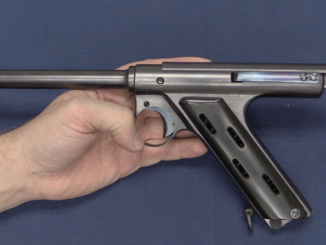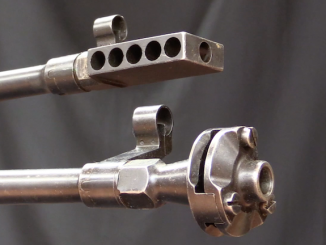Lot 1328 in the September 2020 RIA Premier auction.
Michael Kaufman was a talented gunsmith who worked for the Webley company from 1878 until 1881. While there, he patented a substantially improved clockwork for the gun, removing 5 parts from the system and improving the trigger press. He was paid a royalty for this system, which was tracked by the stamping of “MK” numbers on each gun so equipped. Between 1882 and 1885 Webley made three iterations of revolver with his lockwork, continuously improving the the latch system that held the frame together while firing. This example is a third pattern, of which fewer than 100 were made. It is the first appearance of the classic stirrup latch locking system, which was patented by Webley himself and would be used in all future patterns.




Thank you, Ian. Not as strong as the American S&W cylinder crane, but the British Webley break open was slightly faster loading and robust enough the Brits used the system for two World Wars. It would be interesting if you finished your Webley (and hopefully “Enfield”) series w/ Anderson-Wheeler’s Mk 7 in .357 Magnum, using what they call a “Kaufman latch”!
New Oxford Street was added to the East end of Oxford Street, both to straighten the route and to clear St Giles’ Rookery, perhaps London’s worst slum. The 2 addresses may be because the new street was regarded as an extension of the old to start with, before the extension was named and numbered: but Oxford St has also always been a better address than New Oxford St, so it may just be them lying.
Also: a hundred and five Pounds is one hundred Guineas, and that’s how it would have been priced (a Guinea is one pound one shilling, or £100 5p today).
A Guinea is one pound one shilling, so one Guinea would be £1.05 today.
Correct, missed a decimal point and an &.
And to Mr. Horsfield: But a purchase price of 105 shillings is then …. Five pounds five shillings? One guinea four pounds? How many farthings is that?
£1 in 1882 was worth $4.83 U.S … 100 shillings is £5, so $24.15 in U.S. money. You could buy a new Colt Peacemaker for about $17 in the U.S. at the time (or £4 10s in the U.K., with tariffs and markup … equivalent to $21.74). So, about 11% more expensive (for a UK buyer) than a Colt Peacemaker.
My copy of the 1907 Army & Navy Stores Catalogue shows a .455 Webley WG, similar to the revolver described, at £5 5s. A .455 Colt New Service at £4. A .3o Mauser auto piatol, c/w its holster/stock, at £4 4s. Best of all, a .455 Webley Fosbery at £5 10s.(!). Even given that historic inflation has the 1907 £1 equivalent to £120 in 2020 I still wish I had a time machine.
Ah, Good old £sd. 5 guineas = £5 5s 0d = 105s = 1260d = 5040 farthings. Weighing approximately 14kg! Giving a new meaning to the term about needing deep pockets. Nostalgia is not what it used to be.
At the time this revolver was sold, a pound sterling would have been a gold sovereign, so the gentleman buying it would have paid five sovereigns and five shillings, or if he went for the nickel plate five and a half sovereigns. These days a sovereign is worth about £400, but that tells you more about the debased status of our fiat currency than anything else.
I agree about the box, which is a bit shoddy and certainly not original.
I do love the combat sights. Given the often useless sights you see on pistols even up to WWII, it is impressive to see such practical sights on this pistol. I would say they even put many modern sights to shame.
Webley latch locks cylinder to the frame at both recoiling and rotating directions and accepted as “Strongest” in the break open revolvers. Breaking open paths are blocked through steel connects located at upright angles to the opening movement , not by spring force like S&W…
IzMech was dallying with a top-break .357 revolver back in the 90s.
They seem to have gone for a button pinching release. I doubt enough of them were made to generate any feedback about handiness or sturdiness.
https://modernfirearms.net/en/handguns/double-action-revolvers/russia-double-action-revolvers/izhmeh-mp-412-eng/
There also existed Soviet space revolver, which is top-break, chambered for 5,45×39 mm and also distress radio beacon and folding bayonet, see 5th image from top: https://www.thefirearmblog.com/blog/2017/02/27/toz-81-mars-russian-space-revolver/
As to why a space revolver would be developed, one can only wonder. It’s not like the American space shuttle or any NATO-country spacecraft would have been used to kidnap Cosmonauts.
“(…)why(…)”
Early Soviet space vehicles have landing accuracy like few hundreds kilometers, consider that if all went well:
Landing accuracy plus 175 km / minus 100 km from aim point
and in case of unplanned one:
Emergency reentry at any other time would depend on the cosmonaut first using the Vzor device for orientation. To decide when to re-enter, the cosmonaut had a little clockwork globe that showed current position over the earth. By pushing a button to the right of the globe, it would be advanced to the landing position assuming a standard re-entry at that moment. This was sufficient for an emergency landing somewhere on a continental land mass.
Note especially last sentence. Due to that there was possibility cosmonaut would need to survive in wilderness on their own.
Addendum: these quotes are from http://www.astronautix.com/v/vostok.html
What was the spare cylinder chambered for?
I have seen pistols of that period marked ‘450/455’ and also ‘455/476’, meaning they would accept differing forms of very similar service ammunition. Perhaps the spare cylinder was to cover a similar eventuality? It would be interesting to take closer look.
Is there some gunsmith out there willing to fabricate an ambidextrous stirrup latch for beat-up shootable Mark IVs and VIs owned by frustrated left-handers? It shouldn’t be that hard except for lining up the rear sights.
Dear Bearded Conservative Gen’l: .45 Colt, see link to auction house above.
For what it’s worth, in my view the case itself is a modern one and the label a reproduction showing Reilly’s earlier address in Oxford St. Various such labels being commercially available in the UK. The revolver itself is magnificent and the case displays it nicely but it is not contemporary to the pistol nor, I would suggest, of a matching quality. The reference to government pattern probably refers to the cartridge itself.
Yes, that case is modern homemade junk. The label is a new one, fake aged.
Another clue is that the case opens flat and not the more usual 135 degrees. Maybe a ‘recycled’ cutlery case?
E.M. Reilly was a large manufacturer of pistols, rifles and shotguns from the 1820s on. Here isa short history of the company:
https://www.google.com/url?sa=t&rct=j&q=&esrc=s&source=web&cd=&cad=rja&uact=8&ved=2ahUKEwjMmpWY-trrAhUJKqwKHS3RCF0QFjAAegQIAxAB&url=https%3A%2F%2Fwww.vintageguns.co.uk%2Fmagazine%2Fa-new-history-of-e-m-reilly&usg=AOvVaw3buxmN_ydNO7d5FHg1NO8v
https://www.google.com/url?sa=t&rct=j&q=&esrc=s&source=web&cd=&cad=rja&uact=8&ved=2ahUKEwjMmpWY-trrAhUJKqwKHS3RCF0QFjABegQIAhAB&url=https%3A%2F%2Fwww.vintageguns.co.uk%2Fmagazine%2Fthe-life-of-reilly&usg=AOvVaw1J2fnnuhxWc368qJcNB30i
I first saw mention of the company while ready a history of shotgun target shooting. It should be mentioned that Reilly-made guns dominated competition shooting in the late 19th century.
John
I’m sad to have to agree about the case and the label.
The latch is far later than the gun and the woodwork, other fittings and lining are just not of sufficient quality to be authentic.
Gun cases made at that time for high-end British revolvers were works of considerable craftsmanship in themselves. For example, the lining would not just be stuck to the wood leaving an edge that could peel down – as in this case. Instead a wood router was used which enabled the edges of the material to be glued flush with the wood surface so no cloth edges were exposed.
The label, I suppose, could conceivably be genuine having been peeled from another gun case but IMHO it’s more likely to be an artificially aged modern repro which are for sale all over the place (e.g. https://www.henrykrank.com/antiques/antique-restoration/reproduction-gun-trade-labels/e-m-reilly-and-co-502-new-oxford-street-london-trade-gun-case-label.html)
A pistol like that deserves a better case. There are plenty of craftsmen who still do that quality work including Henry Krank in the UK and Turnbull in the US.
I meant to put Huey (http://www.hueycases.com/) rather than Turnbull (https://www.turnbullrestoration.com/).
Really.
The box looks completely different from others.
https://www.bonhams.com/auctions/11432/lot/106/
https://www.rockislandauction.com/detail/74/423/cased-webleypryse-4-revolver-army-navy-marked
https://www.rockislandauction.com/detail/55/139/webley-pryse-revolver-455
https://dygtyjqp7pi0m.cloudfront.net/i/20383/19368478_1.jpg?v=8D11C0790D35B70
https://dygtyjqp7pi0m.cloudfront.net/i/10387/11025529_1.jpg?v=8CE3D172718D6A0
please can anybody inform me / give information on the following question , I would like to know if there are any new top break / open break revolver designs being made? It seems every top break revolver I see is an old design, seemingly no new designs of this type of revolver are being made, just new copy’s of old designs like Ubertis Russian, schofields or old webleys etc